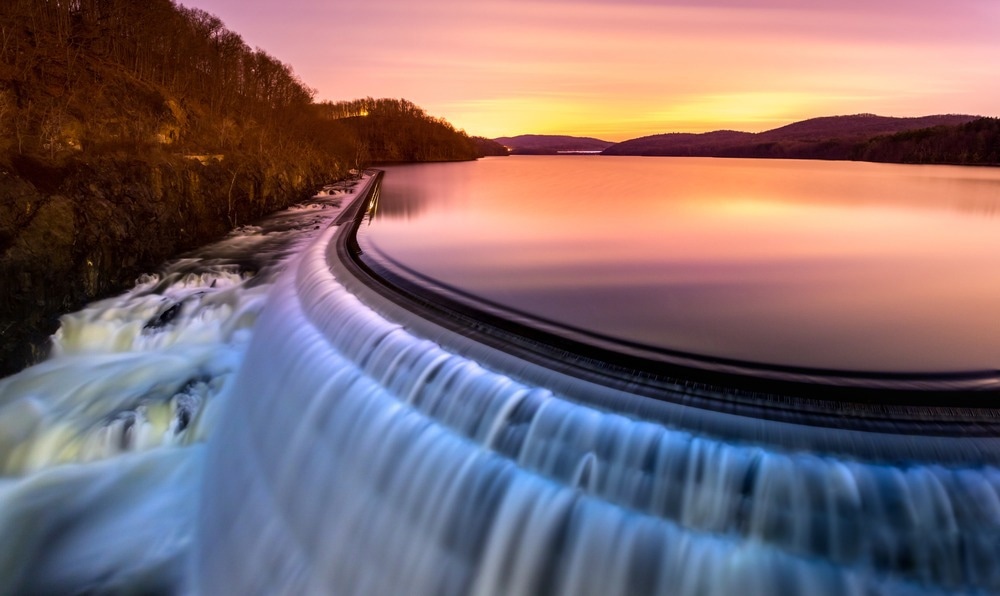A study published in Water estimated the velocity field in highly aerated flow over a stepped spillway without sidewall constrain using the Bubble Image Velocimetry (BIV) method.

Study: Velocity Measurements in Highly Aerated Flow on a Stepped Chute without Sidewall Constraint Using a BIV Technique. Image Credit: Mihai_Andritoiu/Shutterstock.com
Aerated Water Flow
Flow becomes aerated when water is artificially infused with considerable air. Aerated water is commonly used in homes as it produces gentler yet more efficient scrubbing action on the sensitive membranes of the eyes and cheeks.
Aerated Water Flow in Spillways
There has been a lot of interest in the design of stepped spillways since systematic laboratory experiments into the hydraulic performance of the stepped spillways were initiated in the early 1980s.
The absence of sidewalls in a spillway causes the flow to expand laterally, which results in an uneven distribution of transverse flow rate along the chute.
The study of the macroscopic and microscopic characteristics of the highly turbulent flow through stepped spillways has substantially benefited from applying both traditional and cutting-edge metrology in laboratory investigations.
Examples of such applications include high sampling frequency piezoresistive pressure transducers to measure extreme pressures and pressure fluctuations on the step faces, conductivity probes, and back-flushing Pitot tubes to estimate the local velocity and air concentration and PIV for determining the turbulent flow characteristics in the non-aerated flow region.
The development of non-intrusive flow imaging tools such as light detection and ranging systems (LiDAR) or ultrasonic sensors has given rise to innovative methods for determining free-surface turbulence or the characteristics of air-water flow.
Highly aerated flows, particularly in stepped spillways, have also been studied using optical flow and Bubble Image Velocimetry (BIV) approaches.
Using the BIV Method to Measure the Velocity of Aerated Flow
The researchers in this study employed the BIV approach to use its air bubbles caught in the flow as tracers to illustrate the velocity field observed in aerated flow on a stepped spillway without sidewall restriction.
The flow has been analyzed from frontal and lateral perspectives. The velocity field near the intricate flow's free surface has been identified from the frontal images. On the other hand, a typical flow depth and the chute's depth-wise velocity profile have been inferred from the lateral view recordings.
A Contrast Limited Adaptive Histogram Equalization (CLAHE) filter was used for the lateral and frontal analysis of the corresponding velocity fields. The CLAHE filter enhanced the visuals by distributing the most prevalent intensities throughout the range of 0 to 255.
High-speed video cameras captured images, which were then analyzed using particle image velocimetry (PIV) methods. The displacement vectors were computed using a 2D cross-correlation function of two successive frames' discrete Fourier transformation (DFT).
PIVlab—an open-source toolbox accessible in MATLAB—was employed in the current work. The flow velocity field was obtained in this application through image processing using the traditional non-intrusive PIV technique.
Important Findings of the Study
Image pre-processing is required to enhance contrast and highlight the presence of air inside the flow. The size of the interrogation zones did not affect either frontal or lateral examination results.
For high aerated flows, PIVlab is a valuable tool for estimating free-surface velocities from frontal view data by employing air bubbles as tracers. Regardless of the rate at which images are captured, correlations between successive frames are acceptable. However, inaccurate estimates were reported in the partly aerated zone downstream of the origin site.
Frontal view measurements of free-surface velocities reveal a rising transverse component downstream of the inception point, which is caused by the absence of a lateral sidewall. The free-surface velocity corresponds well with the water-air interfacial velocity previously measured using a double-tip fiber optical probe for sufficiently downstream and small dimensionless discharges of the site of origin. However, regardless of the image capture rate, substantial differences were seen in the largest dimensionless discharges.
For 400 fps, the predicted velocity profiles from the lateral view measurements are essentially independent of the interrogation area's size. In contrast, the velocities measured at 200 fps are much lower than those at 400 fps and are strongly influenced by the size of the interrogation area.
The velocity profiles from the normal to the pseudo-bottom, much downstream of the inception point, coincide with the air-water interfacial velocity profiles in the inner section of the skimming flow, with the highest disparities confirmed in the top skimming flow area near the free-surface.
It is counterproductive to produce brightness saturation in the region where the air has already reached the surface to improve the lighting of the darkest area. This makes determining the optimal lighting for both areas quite challenging. It has been determined that providing enough lightening of the region of interest is relevant to improving air performance as a flow tracer.
Reference
Sánchez-Juny, M., Estrella, S., Matos, J., Bladé, E., Martínez-Gomariz, E., & Bonet Gil, E. (2022). Velocity Measurements in Highly Aerated Flow on a Stepped Chute without Sidewall Constraint Using a BIV Technique. Water, 14, 2587. https://www.mdpi.com/2073-4441/14/16/2587/htm
Disclaimer: The views expressed here are those of the author expressed in their private capacity and do not necessarily represent the views of AZoM.com Limited T/A AZoNetwork the owner and operator of this website. This disclaimer forms part of the Terms and conditions of use of this website.